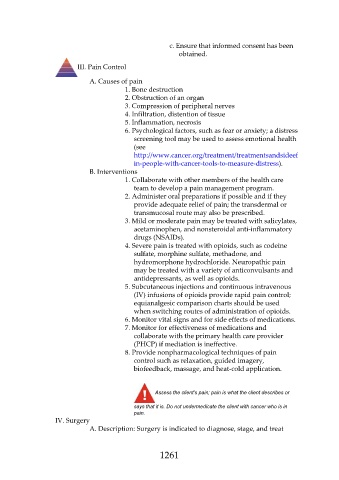Page 1261 - Saunders Comprehensive Review For NCLEX-RN
P. 1261
c. Ensure that informed consent has been
obtained.
III. Pain Control
A. Causes of pain
1. Bone destruction
2. Obstruction of an organ
3. Compression of peripheral nerves
4. Infiltration, distention of tissue
5. Inflammation, necrosis
6. Psychological factors, such as fear or anxiety; a distress
screening tool may be used to assess emotional health
(see
http://www.cancer.org/treatment/treatmentsandsideeffects/emotionalsideeffects/distressinpeoplewithcancer/distress-
in-people-with-cancer-tools-to-measure-distress).
B. Interventions
1. Collaborate with other members of the health care
team to develop a pain management program.
2. Administer oral preparations if possible and if they
provide adequate relief of pain; the transdermal or
transmucosal route may also be prescribed.
3. Mild or moderate pain may be treated with salicylates,
acetaminophen, and nonsteroidal anti-inflammatory
drugs (NSAIDs).
4. Severe pain is treated with opioids, such as codeine
sulfate, morphine sulfate, methadone, and
hydromorphone hydrochloride. Neuropathic pain
may be treated with a variety of anticonvulsants and
antidepressants, as well as opioids.
5. Subcutaneous injections and continuous intravenous
(IV) infusions of opioids provide rapid pain control;
equianalgesic comparison charts should be used
when switching routes of administration of opioids.
6. Monitor vital signs and for side effects of medications.
7. Monitor for effectiveness of medications and
collaborate with the primary health care provider
(PHCP) if mediation is ineffective.
8. Provide nonpharmacological techniques of pain
control such as relaxation, guided imagery,
biofeedback, massage, and heat-cold application.
Assess the client’s pain; pain is what the client describes or
says that it is. Do not undermedicate the client with cancer who is in
pain.
IV. Surgery
A. Description: Surgery is indicated to diagnose, stage, and treat
1261

